PORCELAIN MARKS FROM MEISSEN & DRESDEN:
A Fascinating Tradition of Porcelain Making in Europe
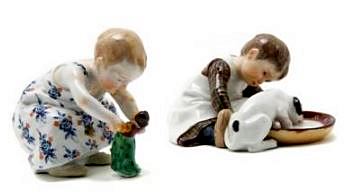
Porcelain has long been a prized possession for collectors and enthusiasts alike, but identifying the markings and origin of pieces can often be a challenge. Meissen and Dresden porcelain are two of the most renowned and coveted types, with a rich history dating back to the 18th century. Whether you're a seasoned collector or just starting out, understanding the intricacies of these porcelain marks can unlock a world of fascinating stories and history. In this article, we'll take a deep dive into the world of Meissen and Dresden porcelain and unravel the mysteries of their unique markings, helping you to become a knowledgeable and informed collector.
Regional Aspects of Porcelain Marks
In most cases, porcelain marks reveal the original manufacturer or maker and the period when they were created. For example, a pair of urns marked with a Sevres mark from ca 1800-1820s would be identified as "A Pair of Sevres Porcelain Urns, ca 1800-1820s". While this process may seem straightforward and it applies to most porcelain antiques and collectibles found in the market today, there are groups of porcelain marks that can be confusing because they are identified based on the location of the maker rather than the actual company. These marks, called regional marks, can vary from region to region, and identifying them requires a bit more research.
One way to decipher regional marks is to look for specific characteristics that are unique to certain regions. For example, if you're examining a piece of porcelain with a mark that reads "Nippon," you can be sure that it was made in Japan, as that was the country's name until the early 20th century. Understanding porcelain marks is essential for any collector or enthusiast who wants to identify and value their porcelain antiques accurately. While the process may seem simple, it can be challenging when it comes to regional marks. But with a little research and patience, you can unlock the secrets of porcelain marks and uncover the stories behind your treasured antiques and collectibles.
However, some regions in the world have a rich tradition in porcelain making, such as the Saxony region of Germany (previously Poland), where Dresden and Meissen are located. Although commonly mistaken as porcelain manufacturers, "Meissen" and "Dresden" actually represent specific cities in the Saxony region, which have several factories or studios in the area. This misnomer is partly explained by the very history of the first indigenous appearance of porcelain in Europe and how its production spread from that region thereafter.
First Porcelain Production in Europe
Porcelain making is an ancient art that dates back to as early as 100 BC, when the Chinese first invented it. The sparkling whiteness of porcelain, which is malleable enough to allow forming elaborate objects yet becomes hard and still very white after firing in a kiln, has been much desired and elusive to European potters for centuries. While clay and terracotta were well-known materials, porcelain was a prized possession, imported in large numbers from China and Japan and adorning the homes of aristocrats and royal palaces in Europe.
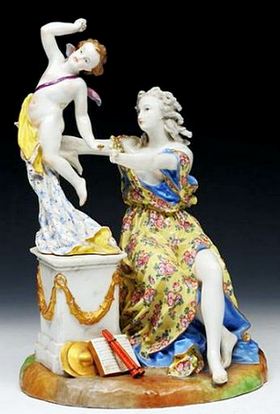
European attempts to recreate Chinese porcelain were largely unsuccessful for a long time. Instead, some small factories resorted to stoneware or earthenware that was painted or "glazed" white, for example, Delftware and some limited production of similar ceramics in Italy, which unfortunately was not as appealing. This led to the expensive importation of Chinese and Japanese porcelain, usually in blue and white or traditional Oriental themes, and the now-common name of "china" (or chinaware) primarily used for porcelain in English-speaking countries.
While the art of porcelain making has come a long way since its origins in China, the rich tradition of regions like Dresden and Meissen continues to shape the production of porcelain today. By understanding the history and misnomers surrounding this ancient art, collectors and enthusiasts can unlock the secrets of porcelain making and appreciate the unique beauty of their treasures.
Meissen and Dresden Porcelain - A Tale of Alchemists and Artisans
Porcelain, a beautiful and durable material prized for its whiteness and translucent appeal, has been a sought-after commodity for centuries. But did you know that Meissen and Dresden are not actual porcelain manufacturers? These names represent specific cities in the Saxony region of Germany (previously Poland), which are famous for their rich tradition in porcelain making.
It all started with the invention of white porcelain by the Chinese over 2,000 years ago. Europeans longed to recreate this superb substance, which was malleable enough to allow for the creation of elaborate objects yet became hard and still very white after firing in a kiln. and were prized possessions of aristocrats and royal palaces. This is why porcelain is commonly referred to as “china” or chinaware in English speaking countries. However, and after centuries of Europeans importing porcelain from China and Japan at great risk and cost, and which usually came in Blue & White or in other traditional Oriental themes, there was a glimpse of hope.
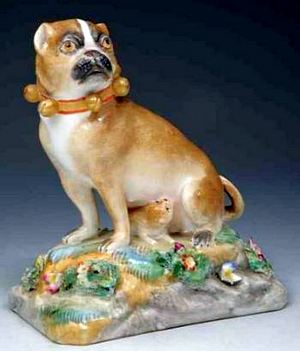
Enter Tschirnhaus and Bottger, two alchemists who experimented with all sorts of concoctions in their laboratories. They received a mixture of local clay from Dresden that seemed to have some similar qualities as porcelain from China. After analyzing this local “mud,” they finally came up with a mixture of Kaolin and Clay that yielded the desired properties to be the first “real” porcelain ever made in a Western country. This took place between 1700 and 1708.
In 1710, Augustus II the Strong, the ruler of Saxony, financed and established a factory in Meissen with Bottger as its first director. This was the very first porcelain manufacturer in Europe and was appropriately named “Royal Porcelain Manufactory in Meissen” only a few miles away from Dresden. Although the name changed somewhat when Germany no longer had a royal family, to “State’s Porcelain Manufactory in Meissen,” most collectors refer to products by this factory as simply “Meissen” or “Dresden.”
The rich tradition of Meissen and Dresden porcelain is fascinating and complex, and these two cities are still at the forefront of porcelain making today.
History of Meissen Porcelain Imitation Marks
Porcelain, a beautiful and durable material prized for its whiteness and translucent appeal, has been a sought-after commodity for centuries. But did you know that Meissen and Dresden are not actual porcelain manufacturers? These names represent specific cities in the Saxony region of Germany (previously Poland), which are famous for their rich tradition in porcelain making.
Meissen was the first porcelain manufacturer in Europe, established in 1710 in Saxony, Germany, and was known for its high-quality porcelain pieces. The first porcelain marks used by the Meissen factory were not officially registered or “copyright protected,” which triggered a huge market of wares made by others. Some of the imitations were of equivalent quality to the authentic Meissen, but they had their marks appear as near-copies or very similar to the original marks used by Meissen. To this day, the "crossed swords of Meissen" are the most copied porcelain mark ever. Other original factory's marks, including the initials KPM, KPF, and MPM, were also extensively copied by other manufacturers in Germany and throughout Europe. Even after the original factory prosecuted the use of these marks, most imitators simply changed them slightly and continued to use them, causing frustration and monetary losses for collectors and dealers.
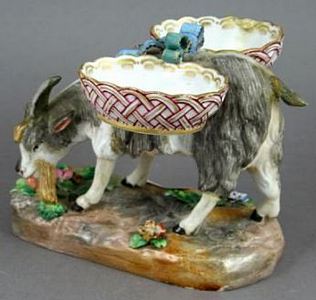
The practice of copying Meissen marks continues to this day, particularly on recent imports from Asia, which can make it challenging to properly value or appraise antique copies. Several prolific imitators of Meissen porcelain, including Helena Wolfsohn, Franziska Hirsch, and Edme Samson, produced items that were almost indistinguishable in quality and used forged Meissen marks that looked practically identical. Some of these imitators were taken to court by Meissen forcing some to change their marks, but others were successful in producing high-quality copies that were almost as valuable as the originals.
Porcelain Decorating Studios in Saxony
In addition to the main factory in Saxony, there were also numerous porcelain decorating studios. These studios were established in the vicinity of Dresden and Meissen as well as in other countries like Austria, France, and England. Although these studios did not have their own porcelain manufacturing, they contributed to decorating by hand-painting and adding handcrafted details to blanks they purchased from nearby factories. The details added were modeled and made of real porcelain by experienced artisans equal in skill to those that worked at the original Meissen factory. In fact, many of these same artisans and craftsmen at Meissen had two jobs, one at the factory and another at one of these studios. Therefore, the level of quality of these "copies" was remarkable, and the similarity to the original Meissen pieces is mostly a testament to these hard-working skilled artisans. Some studios still survive today and produce fine specimens.
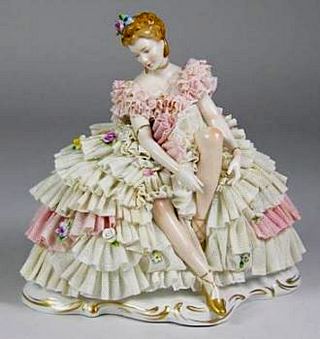
The practice of adding porcelain details to figurines was not limited to items made by the Decorating Studios. In the area of Dresden and Meissen, local freelance artists also developed a technique known as "Dresden Lace," which involved using real lace cloth dipped in liquid porcelain and applied by hand to figurines. This resulted in a delicately fine mesh that was almost indistinguishable from the real lace. The Dresden Lace technique became a popular decorative element in the region, and it was used on many different types of porcelain items, not just figurines.
Unfortunately, because porcelain is brittle at such fine thicknesses, the Dresden Lace parts of older figurines are often found to have tiny breaks or chips but can be repaired by a professional restorer. Nonetheless, the Dresden Lace technique remains a beloved and distinctive element of Dresden and Meissen porcelain, and it is still used today by some porcelain manufacturers in the region. Collectors should keep an eye out for figurines and other porcelain items with Dresden Lace details, as they are highly prized by collectors and can command premium prices.
Conclusion
The terms "Dresden" and "Meissen" primarily refer to the location of the first porcelain factory in a Western country, rather than the factory itself. While "Meissen" has come to be associated specifically with the original factory, these terms are more accurately applied to all of the porcelain facilities and decorating art studios in the region, collectively. Additionally, "Meissen" and "Dresden" also refer to the decorative style that flourished in the region and has continued to be admired and evolve over time. Overall, these terms are used to describe a rich artistic and cultural heritage associated with the area and its contribution to the world of porcelain manufacturing and decorative arts.
Unlock the true value
of your collection with our comprehensive research guides from identifying makers' marks to appraising all kinds of
antiques and collectibles.
Our up-to-date information will give you an accurate understanding of your items' worth. Don't miss out on this
valuable resource - visit our research tools today!
Search our price guide for your
own treasures





